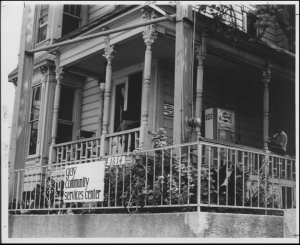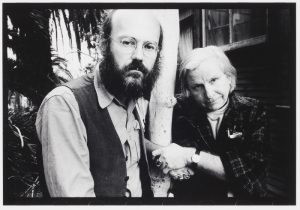In Los Angeles, as elsewhere, it has been the presence of a visible, organized and strong grassroots gay community that has allowed the incredible strides gay people have made since the 1969 Stonewall Rebellion to be possible.
In 1971, when Morris Kight and I expanded the militant work of the Gay Liberation movement in Los Angeles, our objective was the creation of a “gay community” where none had ever existed before.
Our primary vehicle for that social revolution was the creation of the pioneering “Gay Community Services Center” (now called the LA LGBT Center) with each one of those words in its title carefully chosen.
“Gay.” We didn’t use closet words in the name. We were always upfront and in your face about who we were.

“Community.” It was clear that without a community, which was visible, organized and in which we openly assumed responsibility for each other, our liberation would be more difficult, if not impossible.
“Services.” Gay people have suffered a long history of deadly violence and have self-destructively internalized a great deal of hetero supremacy nonsense, resulting in what Gay Liberation called “oppression sickness.” Human services were created specifically to meet the unique needs of gay and lesbian people—a largely wounded, numb, self-hating and fearful people at the time.
“Center.” We were creating a “center” around which a pioneering gay community could coalesce and in which gay people could be openly and constructively engaged.
The plan worked flawlessly. Our time had come. By the end of the 1970’s, a visible and organized gay community existed in Los Angeles for the first time, and GCSC was the largest such organization in the world. Today the Center operates with an annual budget of $121.5 million, 700 employees and 1,800 active monthly volunteers, a truly stunning achievement.
Since the LA LGBT Center opened its current headquarters in Hollywood, at its doorway were the words “Gay Community Services Center,” inlaid with attractive mosaic tiles on the south wall, honoring an important milestone, indeed, where the gay community and the Center began, a visible reminder of our history.
Let’s fast forward to today. Lamentably, recently the GCSC words were cemented over, as if GCSC never existed.
Another example of the rewriting of gay history is the USC library’s ONE Gay Archives, which has a de facto blacklist against Stonewall/Gay Liberation Front of Los Angeles. It surrealistically wants us to believe Gay Liberation did not begin with Stonewall in 1969 but with the conservative, assimilationist, don’t-rock-the-boat-and-behave-and-heteros-will-accept-and-emacipate-us, Republican-led, L.A.-localized homophile effort (1953-1969), a claim lacking in intellectual honesty and historical integrity.
How might we understand this gay historical vandalism? Since the Reagan revolution of the 1980’s, the whole country has moved toward the conservative right, including much of the leadership of the gay community—their liberal lips and conservative feet many times moving in opposite directions.
The community’s ethos has shifted from stalking freedom, community-building, gay and lesbian identity and culture, and addressing the real human needs of gay and lesbian people; replaced by assimilation striving, law reform, bourgeois conformity, superficiality, status, and fame—largely empty calories—with a top down elite leadership based on wealth with its own salaried sycophants like politicians, talkers, fundraisers, celebrities and their kith and kin.
Part of the disconnect is also generational. Gay Liberation, with its revolutionary world view and emphasis on the restructuring of society to benefit all (today called Democratic Socialism), is an embarrassment to the gay and lesbian “me generation” shaped by the social Darwinism and self-absorption of the Reagan era and beyond.
Why is this happening? Today the dominant ideology of the community is gay assimilation, the unexamined assumption that gay people are just like straight people. Assimilationists say that we live in a post-gay world and claim gay community-identity-culture is less and less important as they becomes homogenized homos via ubiquitous social media.
James Baldwin has warned that whenever a minority assimilates into the dominant culture, it always does so on the terms of the dominant culture. And, inherent in assimilation theory and practice is the disappearance of the gay community and the diminution of gay-centered identity and culture.

If this disappearance is news to you, you haven’t been paying attention. As extensively documented in my writings elsewhere, we are seeing that come true in Los Angeles, leaving ordinary gay and lesbian people often socially alienated and spiritually impoverished—even numb and wounded again but in a new, more subtle way.
What can we do about it? David Brooks’ important article in The New York Times (July 27, 2018), “Where American Renewal Begins,” examines one new model of community revitalization, in Baltimore, moving beyond the left and right intellectual prisons we often get caught in.
While historical circumstances in the gay community are different than Baltimore, what is happening there is inspiring. It shows us community renewal is possible, but a new consciousness, paradigm, language and leaders are required.
Critical for the renewal of the gay community are the visionaries, dreamers, warriors, shamans, priests, teachers and public intellectuals among gay and lesbian millennials and the i-generation after them. Our future as a gay people depends on them being spiritually awake and politically astute, but in a radical, new, gay-centered way. It’s why Harry Hay and I called the Radical Faeries into being.
Real movements and community always occur from the bottom up—today grassroots coupled with netroots—never from the top down, like we have in the gay community today, a time of no movement, a time of gay elites protecting an ephemeral status quo.
I ask, “Is gay community resuscitation possible?” I answer emphatically, “Yes!”
But it will take a new generation that connects with the heart and soul of those who have gone before. It will take the birthing of a new gay-centered consciousness, a new community model, a new public language and new, inspiring, soul-led leaders. Gay Liberation shoulders cry out to be stood upon.
